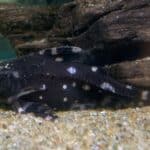Gulper Catfish are an appealing fish to have in your tank due to their large, smooth body, and classic Catfish look that immediately catches your attention. They are also predatory fish, and watching them devour or gulp down their prey is fascinating.
If you’re not really into the idea of feeding live fish to your aquarium pet, then these fish may not be for you. But if you would like a nocturnal addition to your tank then a Gulper Catfish would be a great choice.

These fish need a decent amount of space, and a tank over 100-gallons would be needed to make sure they don’t feel cramped.
Below, you will find everything you need to know about Gulper Catfish, from what they like to eat, how to take care of them, who they can live with, and more.
Species Summary
The Gulper Catfish is also known as the Ogre Catfish and is native to southern Central America and South America, most often spotted in Argentina in the basins of the Rio Negro and Rio Orinoco. They are used to living in slow-moving water.
Due to their size they can handle stronger currents, and you will want to mimic these stronger currents in the tank. A strong filter will also help to keep the tank clear of ammonia, nitrites, and nitrates.
Wood and decorations placed in front of the filter intake will also help to reduce the amount of flow in the tank.
Care Guide
Tank size: Although they are not the largest species of Catfish, a Gulper Catfish does need a generous 100-gallon tank in order to have space to grow and swim. They will become distressed in a tank that is too small.
As well as volume, they also need a tank that is long enough to accommodate their swimming needs. A tank that is 72 inches long is recommended.
Tank mates: As they are carnivorous fish with big appetites, choosing tank mates for a Gulper Catfish can be challenging. They’re rather snake-like in how easily they can devour large prey.
For example, they can eat a fish that is half the size of its own body! They may also attempt to eat a fish of the same size, which causes problems for both their prey and themselves.
Tank mates that are 3-4 inches larger than the Gulper Catfish are recommended, as are fish that are non-aggressive. Gulper Catfish have fins and barbels that can be injured by territorial fish.
As Gulper Catfish are curious and love exploring their surroundings, this puts them at greater risk of such territorial attacks, and this can lead to stress and injury.
As they are nocturnal, you should also pair them with fish that are active during the day. This is so the Gulper Catfish can have free rein of the aquarium in the evening, and the other fish can enjoy the tank in peace while the Gulper Catfish rests.
Suitable tank mates for a Gulper Catfish include Jumbo Angelfish, Large Cichlids, Large Discus, and Leporinus.
Same species tanks: Catfish are notoriously aggressive towards their own species, so it’s best to have only one Gulper Catfish in the tank.
Water parameters: While Gulper Catfish can handle various water qualities, as large predators do they produce a considerable amount of waste, and so it’s important to keep the tank clean. Plus, any tank mates will probably have stricter water quality needs.
When testing the water parameters, make sure to check for ammonia, nitrite, and nitrate levels that can be harmful to your tank. A good filter will not only keep the tank clean, but improve oxygen levels.
The optimal water parameters for Gulper Catfish are a water temperature of 75°F to 84°F (24-29°C), pH levels of 5.6 to 6.8, and water that is generally soft and acidic.
What to put in their tank: Gulper Catfish have scaleless skin which is soft and sensitive, and so it’s best not to overly decorate their tank. Their natural habitat is filled with submerged structures such as wood, so the best decorations for their tank would be driftwood or bogwood that you can find at your local pet store.
Due to their sensitive skin, it’s best to avoid substrate that is sharp and rigid. A good way to tell if substrate would cause problems for your Gulper Catfish is to run your fingers through the substrate a few times.
If your fingers become chafed then you should avoid putting this substrate in a tank with your Gulper Catfish.
Common diseases: The best way to keep your Gulper Catfish healthy is to regularly change their water. This is because of the previously mentioned large volumes of waste they produce.
Dirty water increases the ammonia and nitrate levels, and while Gulper Catfish are hardy fish, it’s important to keep the water temperature and parameters consistent.
Gulper Catfish don’t respond well to change, and if you don’t test the water you are changing out this could pose a risk to your fish. Poor water quality and stress increases the risk of your Gulper Catfish catching parasitic, bacterial, and fungal diseases that can be fatal.
Food & Diet: As Gulper Catfish are carnivorous, you will need to give them feeder fish to provide them with proper nutrition. Because they won’t eat vegetables, you will have to hide them in the feeder fish.
This is known as gut loading, and involves you feeding flake pellets to the feeder fish and then feeding the feeder fish to the Gulper Catfish within an hour.
The feeder fish are not meant to fully digest the vegetables, as this would have no nutritional benefit to the Catfish. Goldfish and Minnows are common feeder fish with fast metabolisms, so it’s important to feed them to the Gulper Catfish when they have full stomachs.
It’s important to note that feeder fish can often carry parasites and other diseases, so you will need to quarantine them before feeding them to your Gulper Catfish. This means the feeder fish will need to be in a separate tank, and treated for parasites whilst in quarantine. After 30 days you can feed them to your Gulper Catfish.
As well as feeder fish, your Gulper Catfish will enjoy seafood offerings like clams, chunked fish flesh, shrimp, and squid. There are now also specialist catfish foods that you can purchase.
However, Gulper Catfish can sometimes reject these prepared foods. Aquarists with Gulper Catfish enjoy hand-feeding them, and by doing this you can train them to take the food. Frozen silversides and shrimp are a good place to start when feeding them prepared foods.
Lifespan
With the right care, Gulper Catfish can live for 8-15 years.
Appearance
With a downturned mouth and whiskers, Gulper Catfish have a typical Catfish look.
You can find them in a range of colors, from light brown to orange to black. They also have a white belly that appears distended after they’ve eaten. They have velvety skin, and because they have poor eyesight, they have barbels to help them find their way around.
They also have relatively small fins compared to the rest of their body. They have a dorsal and adipose fin, two smaller pectoral fins, a broader caudal fin, two pelvic fins, and one anal fin.
Try to avoid touching the pectoral and dorsal fins, as they have sharp rays that can cut you. Also be careful when purchasing a Gulper Catfish, as some sellers clip the sharp rays so they don’t puncture the bag the Catfish is being stored in. Clipping their sting rays could lead to infection.
Size
Gulper Catfish are not the largest species of Catfish, with an average size of 10 inches (25.4 cm).
Behavior & Temperament
Their predatory nature is the most notable behavioral trait of the Gulper Catfish.
As well as being aggressive with other fish, Gulper Catfish are aggressive towards their own species as well as other species of Catfish.
The bigger their tank, however, the less aggressive and territorial they will be.
Breeding
At home breeding of Gulper Catfish is not recommended, due to how violent they can be with one another. There have been no reported successful breedings of Gulper Catfish in home aquariums.
Gender Differences: Male vs Female
Male Catfish are smaller and more narrow than female Catfish, with females growing up to 1 inch larger than males.
Female Catfish also have bigger bellies than males, usually being 1 ½ inches wider. This is because they need more room to carry their eggs.
However, male Catfishes have bigger heads than females, usually 1 inch larger. They also have longer and more brightly colored fins than females.
Fun Facts
- One of the oldest and longest living Catfish in the wild was found in the Mississippi River, and was believed to be 170 years old.
- Because they are bottom-feeders, Catfish can go as deep as 98ft to 230 ft (30-70 meters) to hunt for their food, and can swim at a speed of 2.6 miles per hour.








